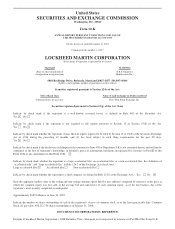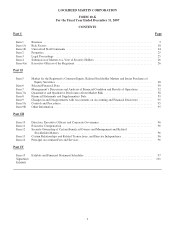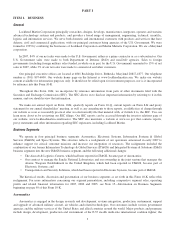Lockheed Martin 2007 Annual Report Download - page 19
Download and view the complete annual report
Please find page 19 of the 2007 Lockheed Martin annual report below. You can navigate through the pages in the report by either clicking on the pages listed below, or by using the keyword search tool below to find specific information within the annual report.which includes test vehicles and pilot production aircraft. Flight tests continue on the test aircraft at Naval Air Station
Patuxent River, Maryland. We have stopped work on Increment 2 at our customer’s request and are working with the U.S.
Navy as it evaluates requirements and funding profiles for the next phase of the program.
In 2007, we were awarded a multi-year contract by the U.S. Navy to produce and integrate mission systems for the new
MH-60R multi-mission helicopter over the next five years. Designed primarily for anti-submarine and anti-surface warfare,
the MH-60R will replace the Navy’s current fleet of SH-60B and SH-60F Seahawk helicopters.
Our tactical wheeled vehicle team delivered four Lightweight Prime Mover (LWPM) vehicles to the U.S. Marine Corps
in 2007. Also in 2007, we delivered the Future Tactical Truck System (FTTS) prototype vehicle to the U.S. Army, which
began road tests in 2007. The purpose of the U.S. Army’s FTTS program was to demonstrate technologies expected to be
used in future truck procurement programs such as the Joint Light Tactical Vehicle (JLTV) program. We developed a JLTV
prototype and began a combination of on-road and off-road testing in 2007, and testing continues in 2008.
We received a 20-year contract to provide basic flight training to the Republic of Singapore Air Force in 2006, the same
year that we were selected as the preferred bidder for the United Kingdom’s Military Flight Training System. We expect to
complete negotiations on a contract early in 2008. In 2007, we won a competition for a multi-year contract and will continue
to provide aircrew training and rehearsal support services for the U.S. Air Force. This program will provide Air Force
Special Operations Command crews with training on a variety of weapon systems. Additionally, we were awarded a program
to develop the U.S. Marine Corps Embedded Platform Logistics system. This advanced embedded capability for Marine
Corps vehicles is intended to use vehicle sensors to capture data to provide predictive information and failure analysis,
allowing the Marines to deploy the best equipment available for mission success. These programs continue and build on our
record of performance in providing logistics and sustainment.
Competition
Electronic Systems’ broad portfolio of products and services competes against the products and services of other large
aerospace, defense and information technology companies, as well as numerous smaller competitors. We often form teams
with other companies that are competitors in other areas to provide customers with the best mix of capabilities to address
specific requirements. The principal factors of competition include technical and management capability, price, past
performance and our ability to provide solutions to our customers’ requirements on a timely basis.
In international sales, the purchasing government’s relationship with the U.S. and its industrial cooperation programs
are also important factors in determining the outcome of competitions. It is common for international customers to require
contractors to comply with their industrial cooperation regulations, sometimes referred to as offset requirements. As a result,
we have undertaken foreign offset agreements as part of securing some international business. For more information
concerning offset agreements, see “Contractual Commitments and Off-Balance Sheet Arrangements” in Management’s
Discussion and Analysis beginning on page 54 of this Form 10-K.
Information Systems & Global Services
Our IS&GS segment is engaged in providing federal services, Information Technology (IT) solutions and advanced
technology expertise across a broad spectrum of applications and customers. IS&GS provides full life cycle support and
highly specialized talent in the areas of software and systems engineering, including capabilities in space, air and ground
systems, and also provides logistics, mission operations support, peacekeeping and nation-building services for a wide
variety of U.S. defense and civil government agencies in the U.S. and abroad.
11
























